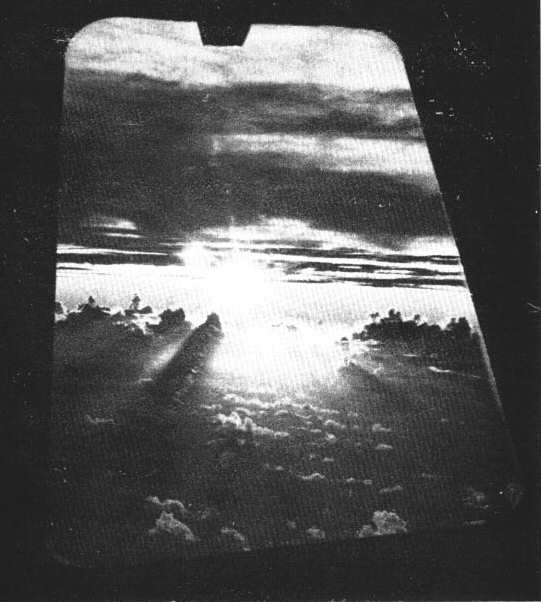 "QUIET BEFORE THE STORM - Somewhere beyond the calm is a violent storm.
"QUIET BEFORE THE STORM - Somewhere beyond the calm is a violent storm.
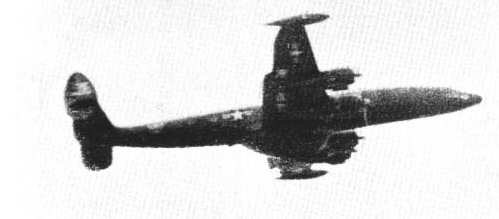 This is a weather reconnaissance aircraft of Airborne Early Warning Squadron One (VW-1)
which is about to penetrate into the eye of a full-blown typhoon.
This is a weather reconnaissance aircraft of Airborne Early Warning Squadron One (VW-1)
which is about to penetrate into the eye of a full-blown typhoon.
THE TIME is 2145 local. A large WC-121 Warning Star with its graceful body identified by two huge radomes and antennas is boring stealthily through the murky Pacific night. Inside the cabin, clustered within a maze of black boxes, wires and cathode ray tubes, the crew of some two dozen men begin the most important phase of their mission.
"Flight, CIC. Recommend heading Zero Thuh-ree Five. Presently hold the eye at four five miles.".
"Roger, CIC. Coming to Zeor Thuh-ree Five"
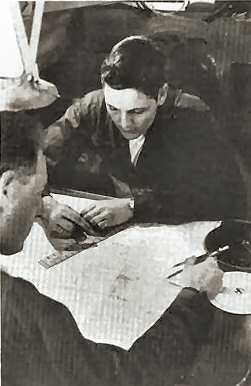 Aerographers plot typhoon statistics.
Aerographers plot typhoon statistics.
In the darkened Combat Information Center, a radar observer plots a course throught the least turbulent areas of the storm's feeder bands. The radar indicates a swirling, white-massed representation of the "lethal lady" and thus the less turbulent areas are easily discerned.
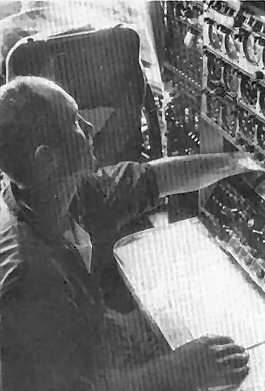 Flight engineers maintain constant fuel chart
Flight engineers maintain constant fuel chart
"Flight, CIC. Will be experiencing moderate turbulence for the next 10 minutes."
"Roger, CIC"
"Crew, Flight. Better find a seat. It's going to be a little rough for a few minutes."
FIRST COMES the rain--like wave after pounding wave of BB shot pummeling the skin of the huge aircraft.
Then the plane begins to sway and bounce with sickening irrgularity, as the flexible wings bend nearly three feet from their normal position. Instruments become difficult to read as they vibrate in their shock absorbing mounts.
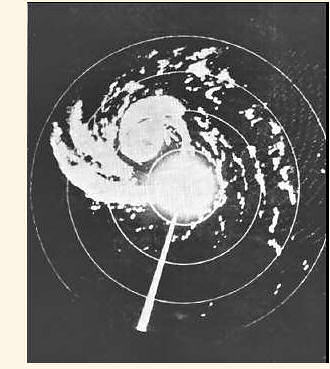 THE CONTACT---The storm appears on the radarscope, and reveals the characteristic shape
of a typhoon.
THE CONTACT---The storm appears on the radarscope, and reveals the characteristic shape
of a typhoon.
Then, even more suddenly than it began, the turbulence stops, and everything is noiselessly smooth. The aircraft has penetrated into the eye of the typhoon.
The placid environment outside the aircraft is dotted by the moon and an occasional shimmering star. The sides of the eye, bathed in the pale moonlight, curve downward toward the center in the shape of a huge football stadium. It is difficult ot comprehend that such a scene of natural, moonlit beauty can be surrounded by such violent weather.
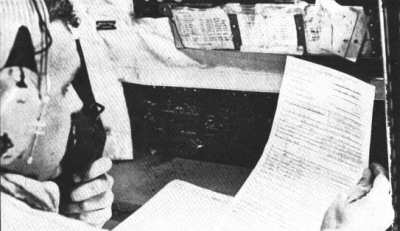 Storm data transmitted to Guam.
Storm data transmitted to Guam.
As the pilot begins to, orbit within the boundaries of the wall clouds, the crew turns to on various jobs. CIC personnel study their scopes for the least turbulent exits. The navigator takes a fix at the storm's center. The meteorologist and aerographers collect weather data such as temperature, barometric pressure, wind speed and humidity, and prepare their eye-message report.
Now another foreign projectile appears in this vast expanse of calm air. A device known as a dropsonde plummets toward sea level. This instrument descends on a parachute and transmits critical information back to the weather crew. A message including all this data is radioed to Fleet Weather Central/Joint Typhoon Warning Center, Guam. With this vital information, Fleet Weather Central issues advisories and messages to all military and civilian installations on Guam, as well as in the entire Western Pacific, giving advance warning of the storm's approach.
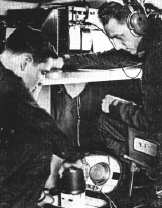 EYE DROP--Observers prepare dropsonde for storm eye..
EYE DROP--Observers prepare dropsonde for storm eye..
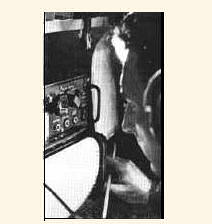 Dropsonde transmission is recorded on graph.
Dropsonde transmission is recorded on graph.
WITH THE FIRST phase of their task complete, the crewmen ready themselves to depart from the calm of the eye, much in the same way they entered. Once outside, this airborne weather observatory flies to specified locations around the storm, gathering and disseminating weather data on each quadrant.
Six hours later comes the second penetration. With this, the "double fix" is complete, thus giving a complete picture of the tropical terror's erratic movements. Now the navigator plots a course for home. Home can be one of many ports of call, including Okinawa, Taiwan, the Philippines, Japan, Wake Island, Kwajalein, and others; but wherever VW-1 lands, the crew finds great relief in removing those sweat-drenched flight suits, soaked by 14 hours of arduous work.
However, in foreign lands, the landing is just the start of work for some. These are the flight maintenance personnel. It's their job to make the bird shipshape while she's on the ground.
Weather reconnaissance, VW-1's primary mission, is a vitally important role played by the energetic officers and men of this Seventh Fleet squadron. However, weather is but one of several VW-1 commitments.
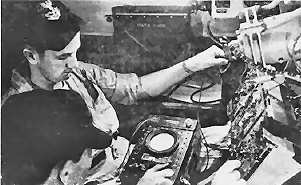 AT's keep aircraft's complicated gear working.
AT's keep aircraft's complicated gear working.
As the name of the squadron implies, airborne early warning is another big shoe for VW-1's flight crews to fill. Ever since August 1964, VW-1 has been in the South China Sea nightly, ready to supply identification of all surface ships and aircraft in the area. Also, in order to meet its AEW commitments, VW-1 maintains an in-country detachment to service its giant Warning Stars. Through many long nights of diligent combat support, VW-1 has continued to be recognized as a hardworking unit of the Seventh Fleet.
There is still a third mission to add to the squadron's myriad responsibilities. Since the decommissioning of Pacific Barrier Squadrons, VW-1 has fallen heir to the training of pilots and aircrewmen for the Pacific users of the C-121.
With 130,000 accident-free flying hours behind it, VW 1 looks forward to many more years of service to the Seventh Fleet. ----Dave Bea

